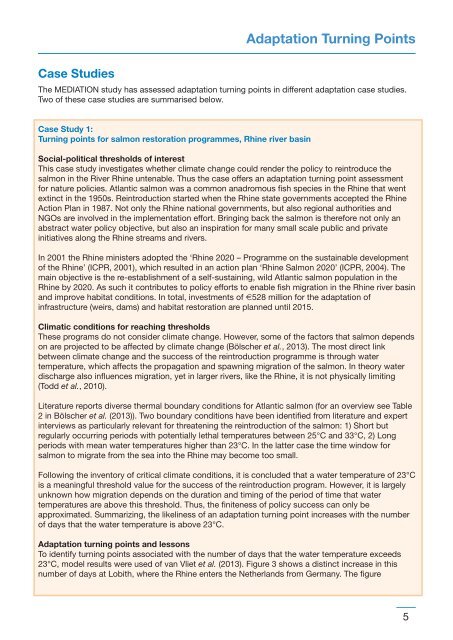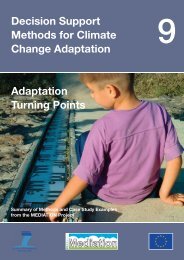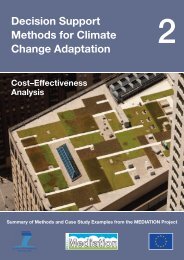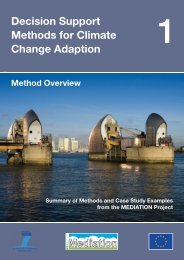Download all Technical Policy Briefing Notes in a single ... - Mediation
Download all Technical Policy Briefing Notes in a single ... - Mediation
Download all Technical Policy Briefing Notes in a single ... - Mediation
- No tags were found...
Create successful ePaper yourself
Turn your PDF publications into a flip-book with our unique Google optimized e-Paper software.
Adaptation Turn<strong>in</strong>g Po<strong>in</strong>tsCase StudiesThe MEDIATION study has assessed adaptation turn<strong>in</strong>g po<strong>in</strong>ts <strong>in</strong> different adaptation case studies.Two of these case studies are summarised below.Case Study 1:Turn<strong>in</strong>g po<strong>in</strong>ts for salmon restoration programmes, Rh<strong>in</strong>e river bas<strong>in</strong>Social-political thresholds of <strong>in</strong>terestThis case study <strong>in</strong>vestigates whether climate change could render the policy to re<strong>in</strong>troduce thesalmon <strong>in</strong> the River Rh<strong>in</strong>e untenable. Thus the case offers an adaptation turn<strong>in</strong>g po<strong>in</strong>t assessmentfor nature policies. Atlantic salmon was a common anadromous fish species <strong>in</strong> the Rh<strong>in</strong>e that wentext<strong>in</strong>ct <strong>in</strong> the 1950s. Re<strong>in</strong>troduction started when the Rh<strong>in</strong>e state governments accepted the Rh<strong>in</strong>eAction Plan <strong>in</strong> 1987. Not only the Rh<strong>in</strong>e national governments, but also regional authorities andNGOs are <strong>in</strong>volved <strong>in</strong> the implementation effort. Br<strong>in</strong>g<strong>in</strong>g back the salmon is therefore not only anabstract water policy objective, but also an <strong>in</strong>spiration for many sm<strong>all</strong> scale public and private<strong>in</strong>itiatives along the Rh<strong>in</strong>e streams and rivers.In 2001 the Rh<strong>in</strong>e m<strong>in</strong>isters adopted the ‘Rh<strong>in</strong>e 2020 – Programme on the susta<strong>in</strong>able developmentof the Rh<strong>in</strong>e’ (ICPR, 2001), which resulted <strong>in</strong> an action plan ‘Rh<strong>in</strong>e Salmon 2020’ (ICPR, 2004). Thema<strong>in</strong> objective is the re-establishment of a self-susta<strong>in</strong><strong>in</strong>g, wild Atlantic salmon population <strong>in</strong> theRh<strong>in</strong>e by 2020. As such it contributes to policy efforts to enable fish migration <strong>in</strong> the Rh<strong>in</strong>e river bas<strong>in</strong>and improve habitat conditions. In total, <strong>in</strong>vestments of €528 million for the adaptation of<strong>in</strong>frastructure (weirs, dams) and habitat restoration are planned until 2015.Climatic conditions for reach<strong>in</strong>g thresholdsThese programs do not consider climate change. However, some of the factors that salmon dependson are projected to be affected by climate change (Bölscher et al., 2013). The most direct l<strong>in</strong>kbetween climate change and the success of the re<strong>in</strong>troduction programme is through watertemperature, which affects the propagation and spawn<strong>in</strong>g migration of the salmon. In theory waterdischarge also <strong>in</strong>fluences migration, yet <strong>in</strong> larger rivers, like the Rh<strong>in</strong>e, it is not physic<strong>all</strong>y limit<strong>in</strong>g(Todd et al., 2010).Literature reports diverse thermal boundary conditions for Atlantic salmon (for an overview see Table2 <strong>in</strong> Bölscher et al. (2013)). Two boundary conditions have been identified from literature and expert<strong>in</strong>terviews as particularly relevant for threaten<strong>in</strong>g the re<strong>in</strong>troduction of the salmon: 1) Short butregularly occurr<strong>in</strong>g periods with potenti<strong>all</strong>y lethal temperatures between 25°C and 33°C, 2) Longperiods with mean water temperatures higher than 23°C. In the latter case the time w<strong>in</strong>dow forsalmon to migrate from the sea <strong>in</strong>to the Rh<strong>in</strong>e may become too sm<strong>all</strong>.Follow<strong>in</strong>g the <strong>in</strong>ventory of critical climate conditions, it is concluded that a water temperature of 23°Cis a mean<strong>in</strong>gful threshold value for the success of the re<strong>in</strong>troduction program. However, it is largelyunknown how migration depends on the duration and tim<strong>in</strong>g of the period of time that watertemperatures are above this threshold. Thus, the f<strong>in</strong>iteness of policy success can only beapproximated. Summariz<strong>in</strong>g, the likel<strong>in</strong>ess of an adaptation turn<strong>in</strong>g po<strong>in</strong>t <strong>in</strong>creases with the numberof days that the water temperature is above 23°C.Adaptation turn<strong>in</strong>g po<strong>in</strong>ts and lessonsTo identify turn<strong>in</strong>g po<strong>in</strong>ts associated with the number of days that the water temperature exceeds23°C, model results were used of van Vliet et al. (2013). Figure 3 shows a dist<strong>in</strong>ct <strong>in</strong>crease <strong>in</strong> thisnumber of days at Lobith, where the Rh<strong>in</strong>e enters the Netherlands from Germany. The figure5





